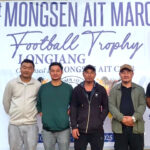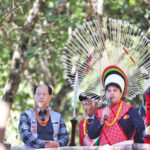The NSCN-IM General Secretary, Th Muivah, has consistently blamed India for the disunity among the Nagas, stating, “Leave the Nagas alone, thence Nagas can be united anytime.” According to the NSCN-IM, as reported in its mouthpiece ‘Nagalim Voice’, it believes that “Delhi will never allow Nagas to unite unless Nagas come to her terms,” while also acknowledging that Delhi knows “Strength is always with unity.”
As the general Naga people’s call for unity grows louder, NSCN-IM asserts that discussing “Naga unity under the Indian constitution” is a waste of time. Instead, it emphasizes the need for a “roadmap for unity,” arguing that “no one talks about a roadmap for Naga unity.” The NSCN-IM demands a “meeting point” on certain issues to achieve unity, contending that “everyone is scared” to remove roadblocks and pave the way for unity.
“We have to understand what unity is for. Is the unity to surrender together or stand together to defend the rights of the Naga national movement?” it asked. “Or is the unity to protect 16 point memorandum of 371(A)? Or is the unity to come together under the Indian constitution like that of the infamous Shillong Accord?” it added.
Notably, the NSCN was formed in protest against the signing of the Shillong Accord, which accepted the Indian Constitution unconditionally. The NSCN-IM continues to demand a “separate constitution” from the Government of India, rejecting both the Shillong Accord and the 16-Point Agreement that led to Article 371(A).
In the context of “unity based on historical and political rights,” the NSCN-IM views that because the essence of upholding this principle theme was left to “common understanding without corrective measure and clear concept,” the idea has taken an ugly turn as some interpret the 16-point memorandum as “unique history and political rights.”
NSCN-IM’s efforts towards unity
According to the NSCN-IM, they made efforts towards “unity” after the declaration of the Naga Ceasefire in 1997. Isak Chishi Swu declared a “General Amnesty” to bring all groups on board for a Naga political solution in the spirit of “forgive and forget.”
“Many came forward from NNC/FGN and the Khaplang group, but some refused to come,” stated the NSCN-IM. In 2005, Isak Chishi Swu issued a ‘clarion call,’ declaring forgiveness for mistakes of fellow comrades from other groups, with an appeal for forgiveness for his group’s mistakes. However, the NSCN-IM said, the response from the other side was insignificant’.
In 2007, despite declaring unity and reconciliation in the national principle, it said, a group of its members led by Azheto, the then Kilo Kilonser, broke away and formed NSCN (U).
NSCN-IM’s view on FNR’s role
During a time when only three Naga political groups existed – NSCN, NSCN (K), and NNC (Non Accordist led by Shingyia) – the Forum for Naga Reconciliation (FNR) was formed in 2008. The NSCN-IM expressed hope for meaningful reconciliation but claimed that the FNR, with its theme of “Naga reconciliation and unity based on the historical and political rights of the Nagas,” couldn’t give it meaningful political significance publicly.
According to the NSCN-IM, the historical account of “wrongdoings and right doings” should be as follows:
1929 Memorandum to Simon Commission – right
1946 NNC formed – right
1947 Naga Independence declared – right
1951 Naga Plebiscite – right
1956 FGN formed – right
1960 16-Point memorandum – wrong
1964 First Indo-Naga Ceasefire & negotiation – right
1973 Revolutionary government surrender – wrong
1975 Shillong Accord – wrong
1978 Martial Law – wrong
1980 NSCN formed – right
1988 Khaplang crisis – wrong
1993 NSCN-IM membership in UNPO – right
1997 Second Indo-Naga Ceasefire for political dialogue – right
To the NSCN-IM, the above historical and political rights and wrongs are essential for consideration in the principles of reconciliation and unity. However, it claimed that the FNR ‘turned cool’, believing that disclosing such accounts would complicate the reconciliation process and push other groups away, rather than bringing them closer.
Recalling an incident in 2011, the NSCN-IM notes that the FNR facilitated the signing of an agreement among the three groups at Niathu Resort. During this event, the three groups agreed in principle to form a “Naga National Government.” It was when FNR asked whether they had leadership issues. According to NSCN-IM, Brig (Retd) Shingyia declared, “In the matter of leadership, there is no dispute. Isak Swu and Th. Muivah are our leaders,” a sentiment the NSCN-IM say was seconded by Gen. Kholi Konyak.
According to the NSCN-IM, this exchange made Isak and Muivah look at each other with “approving smiles and happiness.” However, the NSCN-IM stated that what went wrong after this will be revealed in their next issue of Nagalim Voice.



